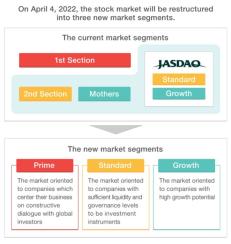The latest revision to Japan’s Corporate Governance Code (“the Code”) was released on June 11. Enacted in 2015 and first revised in 2018, the Code is a set of principles and guidelines meant to steer corporate governance of listed companies. It’s considered a companion piece to Japan’s Stewardship Code, a set of fiduciary responsibilities for institutional investors.
Code changes anticipate 2022 TSE reorganization
The current revision anticipates the restructuring of the Tokyo Stock Exchange (TSE) scheduled to go into effect on April 4, 2022. At that time, the TSE – a subsidiary of Japan Exchange Group, Inc. (JPX) – will reorganize from its current five market segments into three: Prime Market, Standard Market, and Growth Market.At the end of 2021, TSE-listed companies will be asked to choose in which of the three market segments they want to be listed. Companies wishing to be listed on the Prime Market will need to strengthen their governance or explain their policies to shareholders and investors, according to the Code revision. The TSE is implementing this change based on input from institutional investors.
A look at the TSE restructuring plan
The TSE – which merged with the Osaka Securities Exchange (OSE) in January 2013– is currently divided into five market segments: First Section (generally large companies), Second Section (generally established mid-sized companies), Mothers (high growth and emerging stocks), JASDAQ Standard (typically smaller emerging companies) and JASDAQ Growth (typically smaller growth companies).Collectively termed the “Main Markets", the First and Second Sections were reorganized into a single entity of the merged TSE and OSE. However, the Mothers and JASDAQ groups – both emerging markets – have existed independently without being reorganized even after their 2013 merger into JPX due to their distinct characteristics and longstanding rivalry.
The below graphic shows how the five current segments will be restructured into three new groups. While the scheduled April 2022 reorganization has several important objectives – including increasing corporate value and sustainable growth – simplifying the TSE is among them. It’s the only major exchange that uses five groups; exchanges outside Japan, including NASDAQ and the London Stock Exchange, sort companies into two or three categories.
The reorganization will have a significant impact on the portfolios of investors in Japanese stock, as it will necessitate a review of the constituents of the Tokyo Stock Price Index (TOPIX, the market benchmark). Investors should keep a close watch on this and other upcoming changes in the Japanese market.
How TSE market segments will reorganize in 2022

Source: TSE
Code revision to create higher standards in Prime Market
The Code was revised, in part, to set a higher standard for companies to be listed on the Prime Market – using criteria that meets the demands of institutional investors.“The Prime Market is designed with investment criteria of institutional investors in mind, including a listing threshold of at least JPY 10 billion in market capitalization of tradable shares, and adherence to certain standards of corporate governance and sustainability,” says Kentaro Hayashi, Head of Listing at TSE.
The needs of institutional investors were a primary factor in designing the reorganization of the exchange. TSE conducted a series of interviews with institutional investors in Japan and abroad to plan the restructuring, Hayashi adds. “After a series of discussions on how to reorganize the market in a way that would contribute to the enhancement of corporate value and sustainable growth of listed companies, not just a number-crunching exercise, we came up with a proposal to reorganize the market into three distinct segments: Prime, Standard, and Growth Market,” Hayashi explains.

A key objective: Ending vague responses to compliance questions
“It won’t be easy for each of more than 3,700 listed companies in Japan to comply with the entirety of the Code,” says Kazutaka Kuroda, Senior ESG Strategist at Mitsubishi UFJ Morgan Stanley Securities. “Therefore, the basic stance is a principles-based approach: Comply where you can, and where you cannot, explain why you can’t or don’t need to comply.”Before the Code revision, Japanese companies often gave vague responses when asked about their compliance, Kuroda says. “Some companies gave a cursory explanation saying, ‘Let's just say we are implementing all the basic principles. If a shareholder asks for a detailed explanation, say I'm sorry.’ The latest revision makes it difficult to be vague about one’s compliance,” says Kuroda, noting that companies will now be forced either to comply or explain why they don’t.
Broader goals of the Code revision – and Covid’s impact
According to TSE’s Hayashi, a secretariat member of Japan’s Follow-up Council (formally known as the Council of Experts Concerning the Follow-up of Japan’s Stewardship Code and Japan’s Corporate Governance Code), the latest revision focuses on three concepts: 1) sustainability, 2) diversity, and 3) fulfilling the function of a board of directors. He notes that the Follow-up Council’s discussions centered around the importance of “responding to changes.”For additional context, when the Code was enacted in 2015, the focus was on so-called “offensive governance” to retain global competitiveness of Japanese companies. Since then, however, a series of corporate accounting scandals has made “defensive governance” important as well.
As the Follow-up Council was considering how to revise the Code to answer these concerns, the COVID-19 pandemic forced another reckoning. “Coronavirus has drastically altered how people move and communicate,” says Hayashi. “Companies who fail to adapt to these changes will be unable to achieve mid- to long-term sustainability of continuous growth and increased corporate value. Recognition grew among the Follow-up Council that management decision-making is even more important, and that it is essential to strengthen the functions of the board of directors to support this decision-making.”

Key language changes in revision
Japan’s latest Code revision seeks to achieve the following three overarching objectives:Advancing sustainability
The COVID-19 pandemic brought increased attention to the importance of environmental, social and governance factors (ESG). While the original Code of 2015 referenced sustainability (in Section 2, “Appropriate Cooperation with Stakeholders Other Than Shareholders,” General Principle), Kuroda points out, he says the revision takes “a big step forward” by elaborating on the definition of sustainability:
The board should recognize that dealing with sustainability issues such as dealing with climate change and other global environmental issues, respect for human rights, fair and appropriate treatment in the workforce, including employee health and the work environment, fair and reasonable transactions with suppliers, and crisis management for natural disasters, are all important management issues that can lead to earning opportunities as well as risk mitigation…
– Supplementary Principle 2.3.1 of the revised Corporate Governance Code
Further, while sustainability has tended to focus on environmental issues – specifically climate change – companies also need to address sustainability issues that are rapidly gaining attention due to the Corona disaster. To support these efforts, the revised Code requires a higher level of response to environmental concerns and includes a new description of the Taskforce for Climate-related Financial Disclosures (TCFD, created in 2015 to aid public companies in disclosing climate risks and opportunities). In fact, it specifically calls for companies listed in the Prime Market to improve their disclosures:
In particular, companies listed on the Prime Market should…… enhance the quality and quantity of disclosure based on the TCFD recommendations…”
– Section 3 of the revised Corporate Governance Code, “Ensuring Appropriate Information Disclosure and Transparency,” General Principle 3
Promoting diversity
“The period of high economic growth during the post-WWII Showa era, as well as the lost 30 years of the Heisei era, were led by Japanese companies populated and led mainly by Japanese men,” says Hayashi. “It has been noted that a different kind of organization is required in the [current] Reiwa era, and the question is how to integrate the diversity of human resources – not just Japanese men – into the organization.”
To promote greater diversity, the Code revision states:
Companies should present their policies and voluntary and measurable goals for ensuring diversity in the promotion to core human resources, such as the promotion of women, foreign nationals, and midcareer hires to middle managerial positions, as well as disclosing their status.
– Supplementary Principle 2.4.1of the revised Corporate Governance Code
Fulfilling the function of a board of directors
To effectively promote sustainability and diversity, a board of directors must obviously be able to fulfill its functions. As Kuroda observes, “personally, I think the most important thing in this revision is that the roles and responsibilities of the board of directors are also specifically stated in Supplementary Principle 4.2.2: ‘The board should develop a basic policy for the company's sustainability initiatives…’ In short, members of the board of directors are now required to possess a baseline understanding of sustainability.”
Kuroda also applauds the revisions requiring the addition and disclosure of a board member skills matrix. The idea is to identify the knowledge, experience, and abilities that directors should possess – and to disclose how each director stacks up. “What are the requirements for directors and do those serving on the board meet them?” asks Kuroda. “Particularly, when the number of outside directors increases, the skills of individual directors will be diligently scrutinized. The skills matrix will make it easy to see if the requirements are being met,” he says.
Some media reports on the Code revision have emphasized the new requirement that outside independent directors comprise at least one-third of the board at Prime Market companies. What’s important, however, is that both the quality and quantity of directors is now being examined.
Read a translation of the Code revision here.






